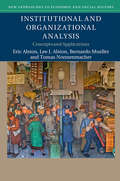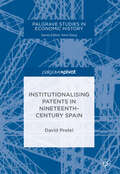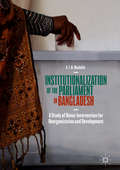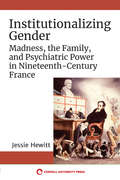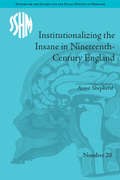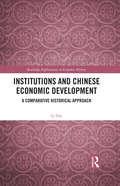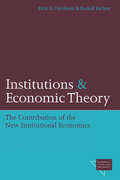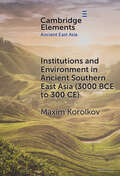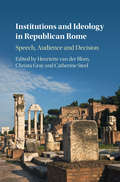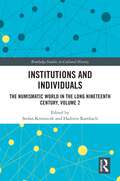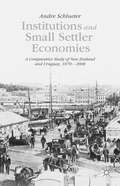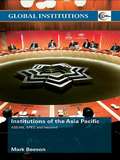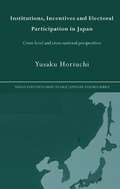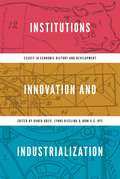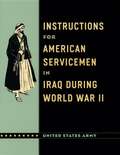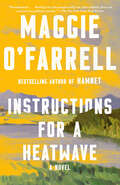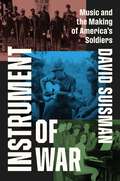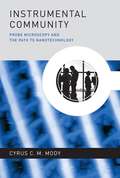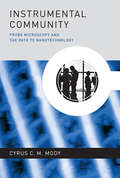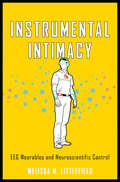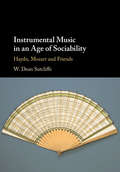- Table View
- List View
Institutional and Organizational Analysis: Concepts and Applications (New Approaches to Economic and Social History)
by Lee J. Alston Bernardo Mueller Eric Alston Tomas NonnenmacherWhat explains the great variability in economic growth and political development across countries? Institutional and organizational analysis has developed since the 1970s into a powerful toolkit, which argues that institutions and norms rather than geography, culture, or technology are the primary causes of sustainable development. Institutions are rules that recognized authorities create and enforce. Norms are rules created by long-standing patterns of behavior, shared by people in a society or organization. They combine to play a role in all organizations, including governments, firms, churches, universities, gangs, and even families. This introduction to the concepts and applications of institutional and organizational analysis uses economic history, economics, law, and political science to inform its theoretical framework. Institutional and organizational analysis becomes the basis to show why the economic and political performance of countries worldwide have not converged, and reveals the lessons to be learned from it for business, law, and public policy.
Institutionalising Patents in Nineteenth-Century Spain (Palgrave Studies in Economic History)
by David PretelThis book examines the development of the Spanish patent system in the years 1826 to 1902, providing a fundamental reassessment of its evolution in an international context. The Spanish case is particularly interesting because of this country’s location on the so-called European periphery and also because of the centrality of its colonial dimension. Pretel gauges the political regulation and organisation of the system, showing how it was established and how it evolved following international patterns of technological globalisation and the emergence of the ‘international patent system’ during the late nineteenth century. Crucially, he highlights the construction and evolution of the patent system in response to the needs of Spain's technologically dependent economy. The degree of industrial backwardness in mid-nineteenth-century Spain set the stage for the institutionalisation of its modern patent system. This institutionalisation process also entailed the introduction of a new technological culture, social infrastructure and narrative that supported intellectual property rights. This book is important reading to all those interested in the history of patents and their role in globalisation.
Institutionalist Theories of Money: An Anthology of the French School
by Pierre Alary Jérôme Blanc Ludovic Desmedt Bruno ThéretThis book gathers several important texts and offers a general overview of the institutionalist approach to money developed in France since the 1980s.These texts highlight the specificities of the French monetary approaches and display their main contributions to the understanding of monetary phenomena - not just in our developed market economies, but also in other societies. By bringing these works to an English-speaking audience for the first time, this book provides a much needed and valuable direct insight to these rich texts, and contributes to related approaches such as post-Keynesian economics and neo-chartalist approaches to money. This book highlights the need for a global vision of money and a clearer link between money and political spheres. It will appeal to students and researchers across various disciplines including but not limited to economics, anthropology, sociology, history and philosophy.
Institutionalization of the Parliament in Bangladesh: A Study of Donor Intervention for Reorganization and Development
by A. T. ObaidullahThis book explores the institutionalization process with regard to the Parliament in Bangladesh, and seeks to identify the main constrains that hinder the Parliament from serving as the uppermost representative body for all segments of society.This book sheds valuable new light on key reform initiatives carried out by donor communities in collaboration with the Bangladesh Parliament between the years 1991 and 2015 by presenting an extensive selection of donor proposals to make the Parliament a more potent political institution. The book also focused on the barriers of strengthening oversight, fiscal oversight in particular, resourcing parliament and its secretariat, hindering gender equality and gender responsiveness, counteracting forces that are weakening rule of law, civil liberty of the citizens, constitutionalism and democratic consolidation in the country. The book presents a comparative picture of the pre- and post-reform Bangladesh Parliament, highlighting on the issue of how much the donor assistance can help promote institutionalization of the parliament and democratic consolidation of a developing country. The book will be of immense value to all scholars interested in democratic governance, administrative reforms, policy studies and the role of parliament as a watchdog ensuring accountability, transparency and national integrity.
Institutionalizing Gender: Madness, the Family, and Psychiatric Power in Nineteenth-Century France
by Jessie HewittThis book examines the influence of gender and family values on the development of nineteenth-century French psychiatry.
Institutionalizing the Insane in Nineteenth-Century England (Studies for the Society for the Social History of Medicine #20)
by Anna ShepherdThe nineteenth century brought an increased awareness of mental disorder, epitomized in the Asylum Acts of 1808 and 1845. Shepherd looks at two very different institutions to provide a nuanced account of the nineteenth-century mental health system.
Institutions and Chinese Economic Development: A Comparative Historical Approach (Routledge Explorations in Economic History)
by Li TanChina’s rise as an economic power has posed some challenging questions: how did China achieve GDP growth that was even faster than the Four Asian Tigers? Is the "Chinese model" superior? Why hasn’t the rapid economic growth lead to democracy in the country as many observers expected? And can China sustain its rapid economic growth with its existing social system? Institutions and Chinese Economic Development: A Comparative Historical Approach explores these questions by studying the historical relationship between institutions and economic development in China, drawing comparisons with England, Japan and other Asian economies as appropriate. The investigation focuses on several junctures in China’s economic development: the starting point of the divergence between China and the West; the externally-provoked industrial development in the late 19th century; and the contemporary Chinese Miracle. The analysis foregrounds the role played by Chinese institutions and examines their effects on both the country’s failure to industrialize in the past and its economic achievements in recent time. The book also asks whether, without reform to the existing state institutions, China might still be subject to the historical dynastic cycles today, despite its recent economic success. This work is of great interest to students and scholars of the Chinese economy, economic history and institutional economics, as well as comparative history and Chinese studies more broadly.
Institutions and Economic Theory: The Contribution of the New Institutional Economics
by Furubotn Eirik G. Richter RudolfA much-needed exploration of the New Institutional Economics, or NIE, including a critical assessment of its central theoretical contributions since the field's early beginnings in the 1960s, is this book's objective. It traces the development of major ideas about the genesis and significance of institutions as these ideas have been presented in the NIE. Given the fundamental understanding underlying work in this new area of research--that transactions involve the use of real resources and have costs--the book views the NIE as an amalgam of transaction-cost economics, property-rights analysis, and contract theory. Efforts are made to explain how the various theoretical strands discussed in the NIE literature fit into the general fabric of modern institutionalism, and how the new concepts put forward can be applied to institutional analysis. Since the new institutionalist approach contrasts sharply with that of the traditional neoclassical model, special attention is given to elucidating the points of difference between the two. And, along these lines, a final chapter deals with the troubling question of whether neoinstitutionalist theory can be advanced by efforts to extend or generalize neoclassical theory. The book will be essential reading for economists attracted to the NIE approach. In addition, scholars from such disciplines as political science, sociology, and law will find the work useful as the NIE continues to gain wide academic acceptance. Eirik G. Furubotn is currently serving as Research Associate, University of Texas at Arlington; he recently retired as James L. West Professor of Economics, Texas A&M University. Rudolf Richter is Professor of Economics, Center for the Study of the New Institutional Economics, University of Saarlandes.
Institutions and Environment in Ancient Southern East Asia (Elements in Ancient East Asia)
by Maxim KorolkovOver the past decades, archaeological exploration of southern China has shattered the image of primitive indigenous people and their pristine environments. It is known, for example, that East Asia's largest settlements and hydraulic infrastructures in the third millennium BCE were located in the Yangzi valley, as were some of the most sophisticated metallurgical centers of the following millennium. If southern East Asia was not a backward periphery of the Central Plains, then what created the power asymmetry that made possible 'China's march toward the Tropics'? What did becoming 'Chinese' practically mean for the local populations south of the Yangzi? Why did some of them decide to do so, and what were the alternatives? This Element focuses on the specific ways people in southern East Asia mastered their environment through two forms of cooperation: centralized and intensive, ultimately represented by the states, and decentralized and extensive, exemplified by interaction networks.
Institutions and Ideology in Republican Rome: Speech, Audience And Decision
by Catherine Steel Henriette Van Der Blom Christa GrayThis volume brings together a distinguished international group of researchers to explore public speech in Republican Rome in its institutional and ideological contexts. The focus throughout is on the interaction between argument, speaker, delivery and action. The chapters consider how speeches acted alongside other factors - such as the identity of the speaker, his alliances, the deployment of invective against opponents, physical location and appearance of other members of the audience, and non-rhetorical threats or incentives - to affect the beliefs and behaviour of the audience. <P><P>Together they offer a range of approaches to these issues and bring attention back to the content of public speech in Republican Rome as well as its form and occurrence. The book will be of interest not only to ancient historians, but also to those working on ancient oratory and to historians and political theorists working on public speech.<P> Offers a holistic and detailed picture of the dynamics and conditions behind world-changing events in Roman history.<P> Restores a focus on the content of public speech in Republican Rome, as well as its forms and occurrence.<P> All ancient languages are translated.
Institutions and Individuals: The Numismatic World in the Long Nineteenth Century, Volume 2 (Routledge Studies in Cultural History)
by Stefan KrmnicekThis second part of the 2 volume collection comprises a collection of essays in English by leading scholars on 19th century institutions and individuals presenting the latest developments in international scholarship on the numismatic world in the long 19th century. In the 19th century, developments in the study and collection of coins set the cornerstone for modern numismatics. This volume comprises a collection of essays in English by international leading scholars that highlight significant figures of 19th century research and the state of the numismatic trade in their time. Centering around collectors and scholars of ancient, medieval, modern, as well as on non-Western coinage and medals against the backdrop of the political, cultural, economic, and social changes of the era, this book presents the latest scholarship on numismatics’ contribution to the cultural history of the 19th century. This volume is essential for students and scholars alike interested in 19th century history and the history of coins.
Institutions and Small Settler Economies
by Andre SchlueterInstitutions and Small Settler Economies provides a comprehensive improvement in our understanding of institutional contributions to economic growth.
Institutions of the Asia-Pacific: ASEAN, APEC and beyond (Global Institutions)
by Mark BeesonThe Asia-Pacific is arguably the most important, but also the most complex and contested, region on the planet. Containing three of the world’s largest economies and some of its most important strategic relationships, the region’s capacity of regional elites to promote continuing economic development whilst simultaneously maintaining peace and stability will be one of the defining challenges of the twenty-first century international order. Intuitively, we might expect regional institutions to play a major role in achieving this. Yet one of the most widely noted characteristics of the Asia-Pacific region has been its relatively modest levels of institutional development thus far. However, things are changing: as individual economies in the Asia-Pacific become more deeply integrated, there is a growing interest in developing and adding to the institutions that already exist. Institutions of the Asia-Pacific examines how this region is developing, and what role established organisations like APEC and new bodies like ASEAN Plus Three are playing in this process. An expert in the field, Mark Beeson introduces the contested nature of the very region itself – should it be the ‘Asia-Pacific’ or ‘East Asia’ to which we pay most attention and expect to see most institutional development. By placing these developments in historical context, he reveals why the very definition of the region remains unsettled and why the political, economic and strategic relations of this remarkably diverse region remain fraught and difficult to manage.
Institutions, Incentives and Electoral Participation in Japan: Cross-Level and Cross-National Perspectives (Nissan Institute/Routledge Japanese Studies)
by Yusaku HoriuchiAmerican and European political scientists have claimed that subnational elections almost always record lower voter turnout than national elections. In Japan, however, municipal elections often record considerably higher turnout than national elections, particularly in small towns and villages. Institutions, Incentives and Electoral Participation in Japan theoretically and empirically explores this puzzling 'turnout twist' phenomenon from comparative perspectives. Based on the rational-choice approach, the book hypothesizes that relative voter turnout in subnational vs. national elections is determined by the relative magnitudes of how much is at stake ('election significance') and how much votes count ('vote significance') in these elections.
Institutions, Innovation, and Industrialization: Essays in Economic History and Development
by Avner Greif Lynne Kiesling John V.C. NyeThis book brings together a group of leading economic historians to examine how institutions, innovation, and industrialization have determined the development of nations. Presented in honor of Joel Mokyr—arguably the preeminent economic historian of his generation—these wide-ranging essays address a host of core economic questions. What are the origins of markets? How do governments shape our economic fortunes? What role has entrepreneurship played in the rise and success of capitalism? Tackling these and other issues, the book looks at coercion and exchange in the markets of twelfth-century China, sovereign debt in the age of Philip II of Spain, the regulation of child labor in nineteenth-century Europe, meat provisioning in pre–Civil War New York, aircraft manufacturing before World War I, and more. The book also features an essay that surveys Mokyr's important contributions to the field of economic history, and an essay by Mokyr himself on the origins of the Industrial Revolution.In addition to the editors, the contributors are Gergely Baics, Hoyt Bleakley, Fabio Braggion, Joyce Burnette, Louis Cain, Mauricio Drelichman, Narly Dwarkasing, Joseph Ferrie, Noel Johnson, Eric Jones, Mark Koyama, Ralf Meisenzahl, Peter Meyer, Joel Mokyr, Lyndon Moore, Cormac Ó Gráda, Rick Szostak, Carolyn Tuttle, Karine van der Beek, Hans-Joachim Voth, and Simone Wegge.
Institutions, Property Rights, and Economic Growth
by Sebastian Galiani Itai SenedThis volume showcases the impact of the work of Douglass C. North, winner of the Nobel Prize and father of the field of new institutional economics. Leading scholars contribute to a substantive discussion that best illustrates the broad reach and depth of Professor North's work. The volume speaks concisely about his legacy across multiple social sciences disciplines, specifically on scholarship pertaining to the understanding of property rights, the institutions that support the system of property rights, and economic growth.
Instructions for American Servicemen in France during World War II
by United States Army“A culturally sensitive and practical work, albeit one that pertains to the highly specific scenario of traveling through France immediately after D-Day.” —Nick Greene, Mental FlossWritten by anonymous War Department staffers to meet the urgent needs of the moment, with no thought of its historical value, Instructions for American Servicemen in France during World War II nevertheless brings to vivid life the closing years of World War II—when optimism was growing, but a long, demanding road still lay ahead.After lying unseen in Army archives for decades, this remarkable guide is now available in a new facsimile edition that reproduces the full text and illustrations of the original along with a new introduction by Rick Atkinson setting the book in context.Written in a straightforward, personal tone, the pamphlet is equal parts guidebook, cultural snapshot, and propaganda piece. A central aim is to dispel any prejudices American soldiers may have about the French—especially relating to their quick capitulation in 1940. Warning soldiers that the defeat “is a raw spot which the Nazis have been riding” since the occupation began, Instructions is careful to highlight France’s long historical role as a major U.S. ally. Following that is a brief, fascinating sketch of the French character (“The French are mentally quick;” “Rich or poor, they are economical”) and stark reminders of the deprivation the French have endured under occupation. Yet an air of reassuring confidence pervades the final section of the pamphlet, which reads like a straightforward tourists’ guide to Paris and the provinces—like a promise of better days to come once the soldiers complete their mission.
Instructions for American Servicemen in Iraq during World War II
by United States Army“American success or failure in Iraq may well depend on whether the Iraqis like American soldiers or not.” The U.S. military could certainly have used that bit of wisdom in 2003, as violence began to eclipse the Iraq War’s early successes. Ironically, had the Army only looked in its own archives, they would have found it—that piece of advice is from a manual the U.S. War Department handed out to American servicemen posted in Iraq back in 1943. The advice in Instructions for American Servicemen in Iraq during World War II,presented here in a new facsimile edition, retains a surprising, even haunting, relevance in light of today’s muddled efforts to win Iraqi hearts and minds. Designed to help American soldiers understand and cope with what was at the time an utterly unfamiliar culture—the manual explains how to pronounce the word Iraq, for instance—this brief, accessible handbook mixes do-and-don’t-style tips (“Always respect the Moslem women.” “Talk Arabic if you can to the people. No matter how badly you do it, they will like it.”) with general observations on Iraqi history and society. The book’s overall message still rings true—dramatically so—more than sixty years later: treat an Iraqi and his family with honor and respect, and you will have a strong ally; treat him with disrespect and you will create an unyielding enemy. With a foreword by Lieutenant Colonel John A. Nagl reflecting on the manual’s continuing applicability—and lamenting that it was unknown at the start of the invasion—this new edition of Instructions for American Servicemen in Iraq will be essential reading for anyone who cares about the future of Iraq and the fate of the American soldiers serving there.
Instructions for His Generals
by Gen. Thomas R. Phillips Frederick The GreatThe king of Prussia from 1740 to 1786, Frederick the Great ranks among eighteenth-century Europe's most enlightened rulers. In addition to abolishing serfdom in his domains and promoting religious tolerance, he was an ardent patron of the arts and an accomplished musician. "Diplomacy without arms," he observed, "is like music without instruments." Frederick's expertise at military matters is reflected in his successful defense of his territory during the Seven Years' War, in which he fought all the great powers of Europe. His brilliant theories on strategy, tactics, and discipline are all explained in this vital text."War is not an affair of chance," Frederick asserted, adding that "a great deal of knowledge, study, and meditation is necessary to conduct it well." In this book, he presents the fundamentals of warfare, discussing such timeless considerations as leadership qualities, the value of surprise, and ways to conquer an enemy who possesses superior forces. The soundness of his advice was endorsed by Napoleon himself, who once advised, "Read and re-read the campaigns of Alexander, Hannibal, Caesar . . . and Frederick. This is the only way to become a great captain and to master the secrets of the art of war."
Instructions for a Heatwave: A novel (Vintage Contemporaries)
by Maggie O'FarrellSophisticated, intelligent, impossible to put down, Maggie O'Farrell's beguiling novels--After You'd Gone, winner of a Betty Trask Award; The Distance Between Us, winner of a Somerset Maugham Award; The Hand That First Held Mine, winner of the Costa Novel Award; and her unforgettable bestseller The Vanishing Act of Esme Lennox--blend richly textured psychological drama with page-turning suspense. Instructions for a Heatwave finds her at the top of her game, with a novel about a family crisis set during the legendary British heatwave of 1976. Gretta Riordan wakes on a stultifying July morning to find that her husband of forty years has gone to get the paper and vanished, cleaning out his bank account along the way. Gretta's three grown children converge on their parents' home for the first time in years: Michael Francis, a history teacher whose marriage is failing; Monica, with two stepdaughters who despise her and a blighted past that has driven away the younger sister she once adored; and Aoife, the youngest, now living in Manhattan, a smart, immensely resourceful young woman who has arranged her entire life to conceal a devastating secret. Maggie O'Farrell writes with exceptional grace and sensitivity about marriage, about the mysteries that inhere within families, and the fault lines over which we build our lives--the secrets we hide from the people who know and love us best. In a novel that stretches from the heart of London to New York City's Upper West Side to a remote village on the coast of Ireland, O'Farrell paints a bracing portrait of a family falling apart and coming together with hard-won, life-changing truths about who they really are.
Instrument of War: Music and the Making of America's Soldiers
by David SuismanAn original history of music in the lives of American soldiers. Since the Civil War, music has coursed through the United States military. Soldiers have sung while marching, listened to phonographs and armed forces radio, and packed the seats at large-scale USO shows. “Reveille” has roused soldiers in the morning and “Taps” has marked the end of a long day. Whether the sounds came from brass instruments, weary and homesick singers, or a pair of heavily used earbuds, where there was war, there was music, too. Instrument of War is a first-of-its-kind study of music in the lives of American soldiers. Although musical activity has been part of war since time immemorial, the significance of the US military as a musical institution has generally gone unnoticed. Historian David Suisman traces how the US military used—and continues to use—music to train soldiers and regulate military life, and how soldiers themselves have turned to music to cope with war’s emotional and psychological realities. Opening our ears to these practices, Suisman reveals how music has enabled more than a century and a half of American war-making. Instrument of War unsettles assumptions about music as a force of uplift and beauty, demonstrating how it has also been entangled in large-scale state violence. Whether it involves chanting “Sound off!” in basic training, switching on a phonograph or radio, or cueing up an iPod playlist while out on patrol, the sound of music has long resonated in soldiers’ wartime experiences. Now we all can finally hear it.
Instrumental Community
by Cyrus C. M. ModyThe scanning tunneling microscope (STM) has been hailed as the "key enabling discovery for nanotechnology," the catalyst for a scientific field that attracts nearly $20 billion in funding each year. In Instrumental Community, Cyrus Mody argues that this technology-centric view does not explain how these microscopes helped to launch nanotechnology--and fails to acknowledge the agency of the microscopists in making the STM and its variants critically important tools. Mody tells the story of the invention, spread, and commercialization of scanning probe microscopy in terms of the networked structures of collaboration and competition that came into being within a diverse, colorful, and sometimes fractious community of researchers. By forming a community, he argues, these researchers were able to innovate rapidly, share the microscopes with a wide range of users, and generate prestige (including the 1986 Nobel Prize in Physics) and profit (as the technology found applications in industry). Mody shows that both the technology of probe microscopy and the community model offered by the probe microscopists contributed to the development of political and scientific support for nanotechnology and the global funding initiatives that followed. In the course of his account, Mody charts the shifts in U. S. science policy over the last forty years--from the decline in federal basic research funding in the 1970s through the rise in academic patenting in the 1980s to the emergence of nanotechnology discourse in the 1990s--that have resulted in today's increasing emphasis on the commercialization of academic research.
Instrumental Community: Probe Microscopy and the Path to Nanotechnology (Inside Technology)
by Cyrus C. ModyHow networked structures of collaboration and competition within a community of researchers led to the invention, spread, and commercialization of scanning probe microscopy.The scanning tunneling microscope (STM) has been hailed as the “key enabling discovery for nanotechnology,” the catalyst for a scientific field that attracts nearly $20 billion in funding each year. In Instrumental Community, Cyrus Mody argues that this technology-centric view does not explain how these microscopes helped to launch nanotechnology—and fails to acknowledge the agency of the microscopists in making the STM and its variants critically important tools. Mody tells the story of the invention, spread, and commercialization of scanning probe microscopy in terms of the networked structures of collaboration and competition that came into being within a diverse, colorful, and sometimes fractious community of researchers. By forming a community, he argues, these researchers were able to innovate rapidly, share the microscopes with a wide range of users, and generate prestige (including the 1986 Nobel Prize in Physics) and profit (as the technology found applications in industry).Mody shows that both the technology of probe microscopy and the community model offered by the probe microscopists contributed to the development of political and scientific support for nanotechnology and the global funding initiatives that followed. In the course of his account, Mody charts the shifts in U.S. science policy over the last forty years—from the decline in federal basic research funding in the 1970s through the rise in academic patenting in the 1980s to the emergence of nanotechnology discourse in the 1990s—that have resulted in today's increasing emphasis on the commercialization of academic research.
Instrumental Intimacy: EEG Wearables and Neuroscientific Control
by Melissa M. LittlefieldA critical examination of the rise of wearable EEG monitors.From Fitbits to GPS trackers, wearables promise to help us understand and improve ourselves in quantified ways. We count our steps, track our location, and even monitor our brain waves as we strive to achieve better fitness, clearer direction, or a more focused mind. But why do we rely on wearables to learn about ourselves? In Instrumental Intimacy, Melissa M. Littlefield questions our desire for mechanistic guidance by examining brain-based EEG wearables that promise to improve sleep, relationships, self-knowledge, and learning. Littlefield focuses specifically on EEGs’ transition out of the laboratory and into the hands of consumers. While other brain-imaging technologies (such as MRI, PET, and MEG) are used only in specialized laboratories, human electroencephalography (a.k.a. EEG) is embedded in portable, user-friendly devices. These direct-to-consumer wearables visualize brain activity as accessible data, and many offer the promise of self-optimization.Littlefield’s illuminating book brings the histories of EEG to bear on the contemporary development of EEG wearables via case studies of EEG-based sleep aids, bio-mapping instruments, fashionable surveillance tools, and athletic training devices. The author argues that, over the past century, applied uses of EEG helped to create new states of mind to be monitored and manipulated, as well as discourses about the existence of brain waves and their viability as a tool for brain optimization. By contextualizing and analyzing EEG wearables, Instrumental Intimacy provides a crucial intervention in an emergent consumer market and in the scholarly fields of STS, critical neuroscience, and the history of technology.
Instrumental Music in an Age of Sociability: Haydn, Mozart and Friends
by W. Dean SutcliffeSociability may be a key term of reference for eighteenth-century studies as a whole, but it has not yet developed an especially strong profile in music scholarship. Many of the associations that it brings do not fit comfortably with a later imperative of individual expression. W. Dean Sutcliffe invites us to face up to the challenge of re-evaluating the communicative rationales that lie behind later eighteenth-century instrumental style. Taking a behavioural perspective, he divides sociability into 'technical' and 'affective' realms, involving close attention both to particular recurring musical patterns as well as to some of the style's most salient expressive attributes. The book addresses a broad span of the instrumental production of the era, with Haydn as the pivotal figure. Close readings of a variety of works are embedded in an encompassing consideration of the reception of this music.
